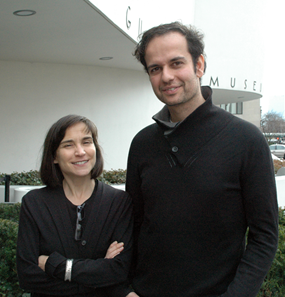
Nancy Spector & Tino Sehgal
Photo: David Velasco
Photo: David Velasco
NANCY SPECTOR, Deputy Director and Chief Curator of the Guggenheim Museum in New York, on This Progress (2006) by Tino Sehgal
Though I have many favorite artists, a number of whom I’ve had the privilege of working with closely on exhibitions, it was surprisingly easy to identify the one art work that has made the most indelible impression on me. Presented as the centerpiece of Tino Sehgal’s solo exhibition at the Guggenheim Museum in 2010, This Progress (2006) fundamentally altered my understanding about how art can function in the world. In place of the traditional object – be it a painting, video, photograph, or installation – the German artist presents what he terms »constructed situations«, live enactments whose only resource is human energy. His antipathy toward the object stems from a fierce political conviction regarding the excessive proliferation of goods in Western culture. Using the museum and its related institutions – galleries, art fairs, and private collections – as his arena, Sehgal presents an alternative mode of production, one that utilizes action instead of material. His art is ephemeral and transitory, but like any other work of art, it can be sold, collected, and reenacted. While the artist does not allow his work to be documented by photography, film, certificate, or score, it can be written about or transmitted through an interpretive chain, constructed by recollection and the spoken word. Take this column as one such mode of retelling, a personal chronicle of my own experience with the piece.
Originally conceived for the ICA in London, This Progress was beautifully adapted to the Guggenheim’s Frank Lloyd Wright-designed spiraling rotunda,which was completely emptied of any objects for the duration of the exhibition. The piece constituted a choreographed conversation that spanned each viewer’s journey through the space, from bottom to top, from an initial question to a final exchange. Along this journey, audience members met representatives or »interpreters« from four generations: children, teenagers, young adults, and the elderly, who engaged them in an ever-mutating discussion predicated on the concept of progress. No two conversations were alike; they depended solely upon the responses and interests of the viewers. What remained unvaried was the structure of the piece, which, in its progression up the ramps, mirrored (not uncritically) the utopian, modernist ideals embedded in the museum’s architecture.
In This Progress, and his performative work in general, Sehgal seeks to elide the gap between his art and audience, eliminating any sense of a didactic intervention, proscenium arch or pedestal. The audience’s role is expanded, and becomes absolutely critical to the work’s meaning. Sehgal’s art empowers the viewer not just to experience and interpret what he or she encounters but also to play a fundamental role in the realization of the piece. At the Guggenheim, with our thousands upon thousands of visitors, each and everyone was offered a chance to participate in and shape This Progress. The work functioned as an art form for the masses, but was tailored to each individual experience. Sehgal’s project also activates and engages the viewer’s subjectivity in a way that recalls the poignantly participatory work of Felix Gonzalez-Torres, whose own retrospective was shown on the same ramps fourteen years earlier.
